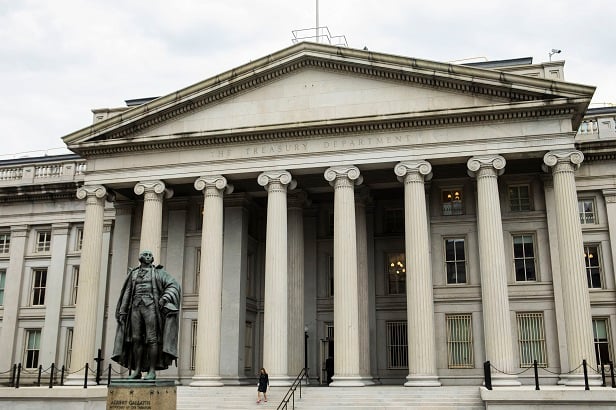 US Department of the Treasury. Photo by Shutterstock.
US Department of the Treasury. Photo by Shutterstock.
➤➤ Join the GlobeSt.APARTMENTS (formerly RealShare) conference October 29-30 in Los Angeles. The event will analyze the opportunity in the emerging trends and conditions of the multifamily market. Don't miss out on joining the 1000+ of the industry's top owners, investors, developers, brokers and financiers as they gather for THE MULTIFAMILY EVENT OF THE YEAR! Click here to register and view the agenda.
WASHINGTON, DC—The Trump administration has released a long-awaited and comprehensive plan that would privatize Fannie Mae and Freddie Mac and also restructure the caps on multifamily lending by the GSEs.
In some ways this is familiar territory for the market—privatizing the GSEs would essentially mean returning them to the status they had before they were taken into conservatorship during the financial crisis. And the Administration has made clear that the backstop would continue after Fannie Mae and Freddie Mac are privatized. Overall, however, the goal of the plan is to limit the GSEs' role in housing finance.
Some elements of the plan could take years to implement, but there are also administrative steps that can be taken right now to nudge things along, according to Alex Pollock, R Street Institute Finance Senior Fellow and former CEO of the Federal Home Loan Bank of Chicago. For example, the capital requirements for Fannie and Freddie could be increased and regulations that especially favor the GSEs over competitors could be removed, he says.
Changes to Multifamily Lending
The plan also calls for a revamp of how the cap on multifamily lending is calculated. The proposal notes that the exemptions to the cap—in particular green energy loans—have allowed GSE multifamily lending to grow unabated. The report says that: "In part because of these broad exemptions, the caps have not been effective in limiting the GSEs' multifamily footprint. The GSEs have grown from owning or guaranteeing 25% of outstanding multifamily debt in early 2008 to almost 40% today. That share could climb, as the GSEs have acquired approximately 50% of recent multifamily originations."
It asks that Congress and Federal Housing Finance Agency revisit the framework to make sure the GSEs' support of the multifamily secondary market is tailored to an affordability mission. One administrative step that could be taken, it suggested, was revamping the existing cap on the GSEs' annual acquisitions to one that is based on the multifamily guarantors' share of outstanding multifamily debt, among other factors. This would ensure that private sector sources of capital are not crowded out, while also permitting more acquisitions during periods of high refinancings, it said.
Rent Control Laws
The proposed plan also makes a nod to the growing number of rent control laws that various jurisdictions are adopting. Such laws, it said, can decrease the supply and quality of the available housing. "Scarce government subsidies should not be used to offset the adverse effects of these laws. By limiting the rental income on multifamily properties, these laws also increase the credit and other risks associated with GSI acquired loans that are secured by multifamily properties in rent-controlled jurisdictions."
In what could be another administrative change, the plan proposes that the FHFA revisit the GSEs' underwriting criteria for acquisitions of multifamily loans secured by properties in rent-controlled jurisdictions, perhaps prescribing lower loan-to-value ratio limits or other underwriting restrictions on these acquisitions.
All together the plan includes nearly 50 recommended legislative and administrative reforms that limit the role of the federal government in the housing finance system and promote competition.
© Touchpoint Markets, All Rights Reserved. Request academic re-use from www.copyright.com. All other uses, submit a request to [email protected]. For more inforrmation visit Asset & Logo Licensing.







